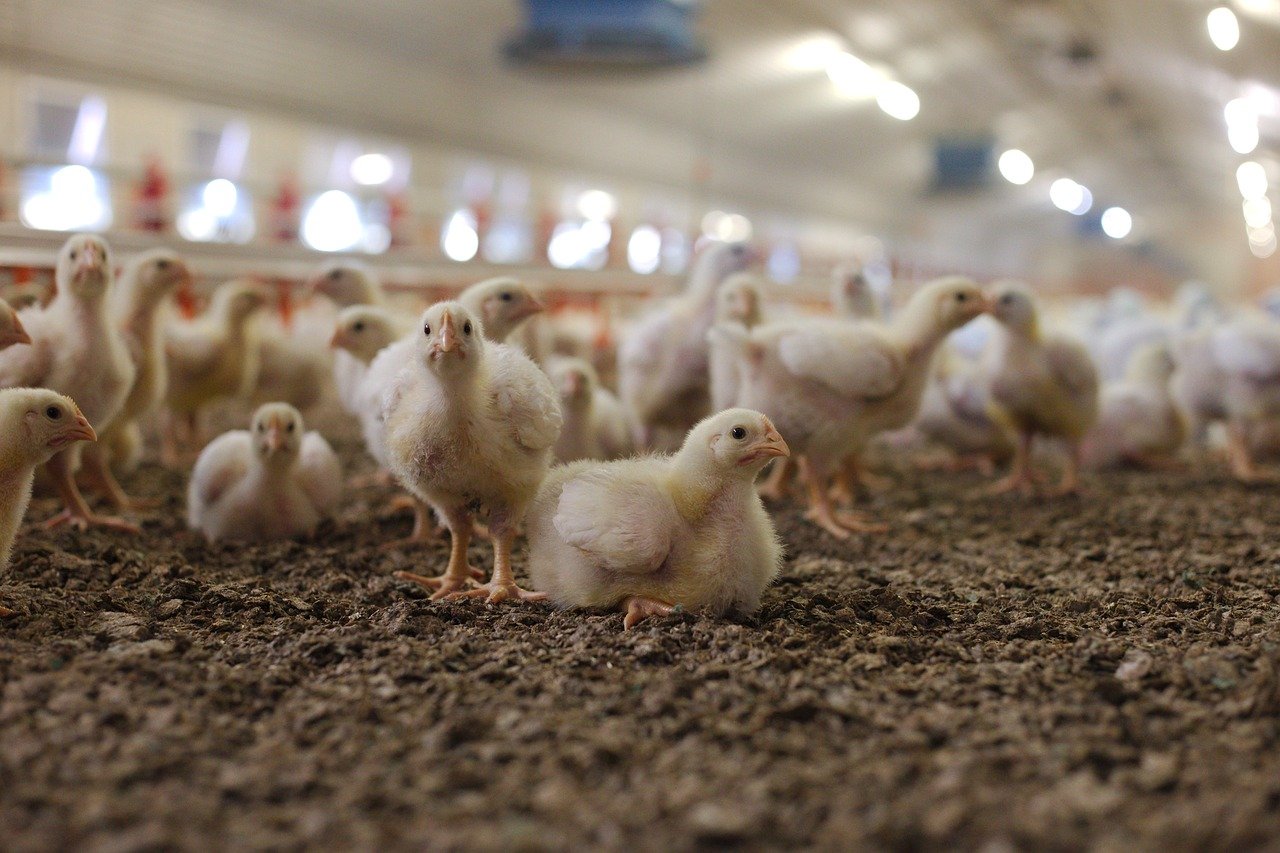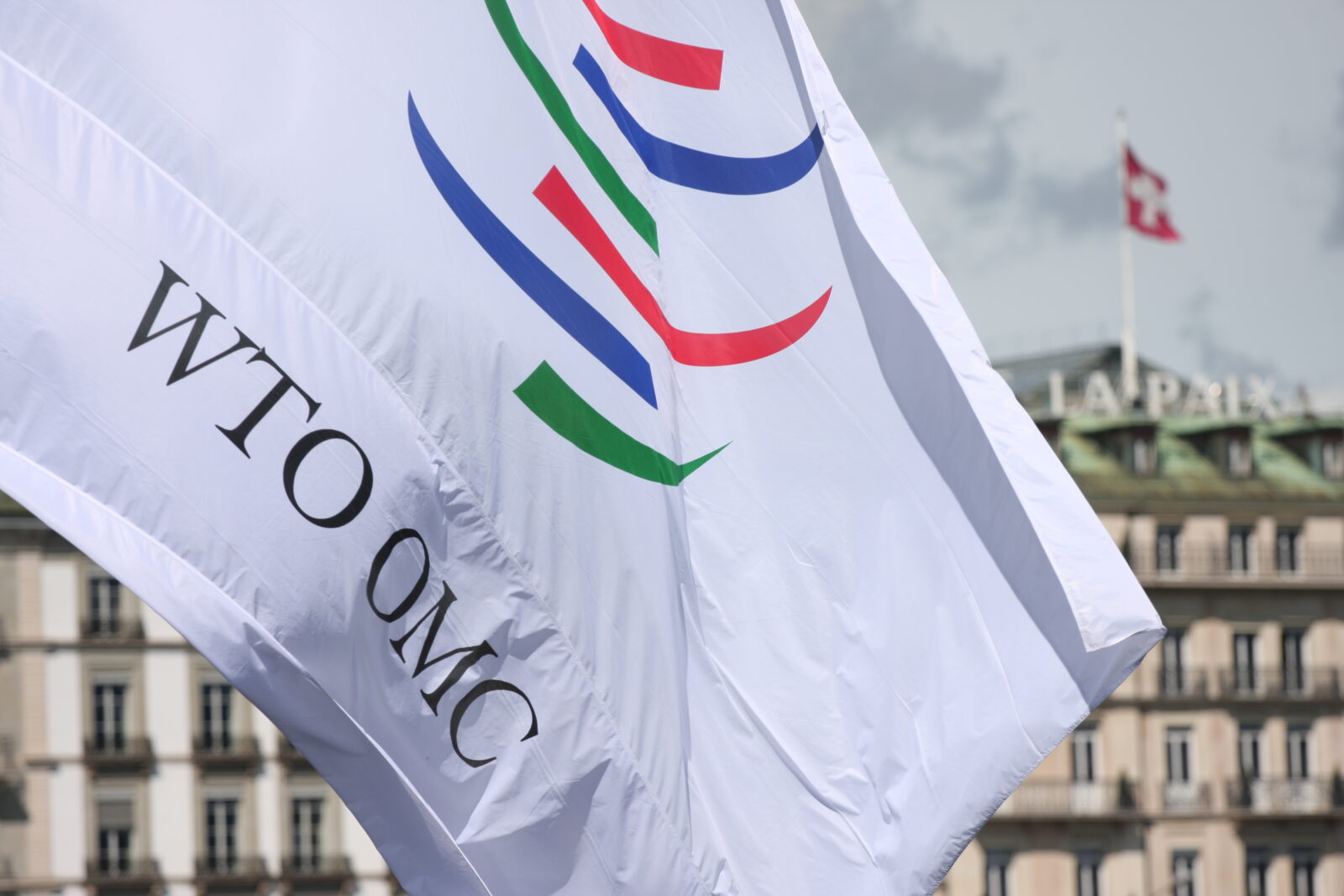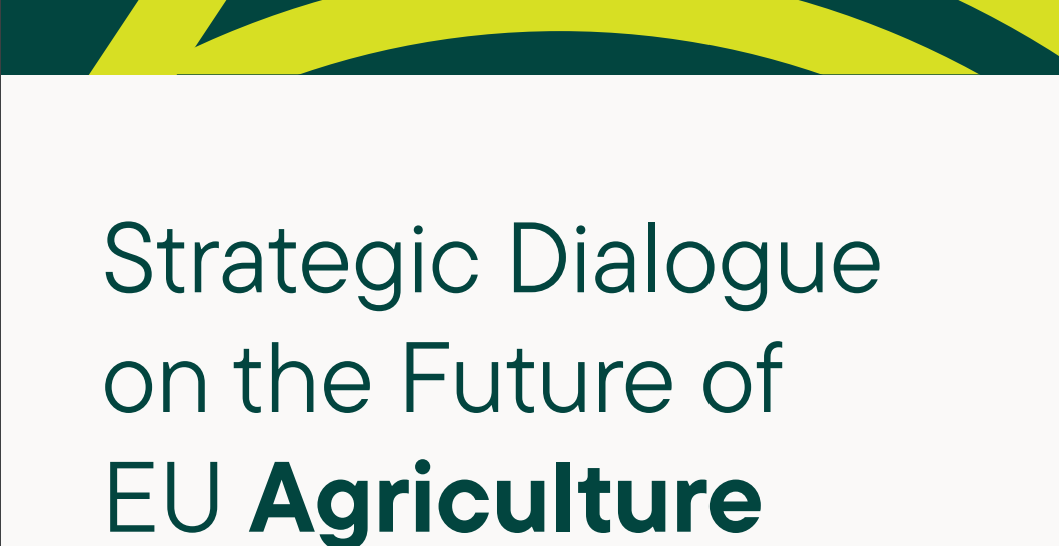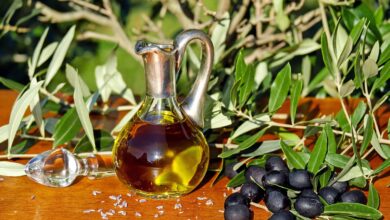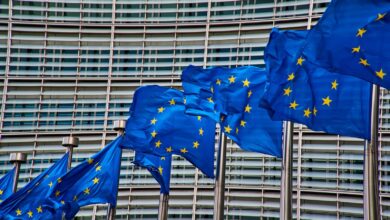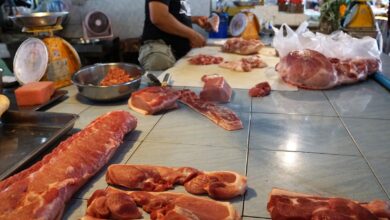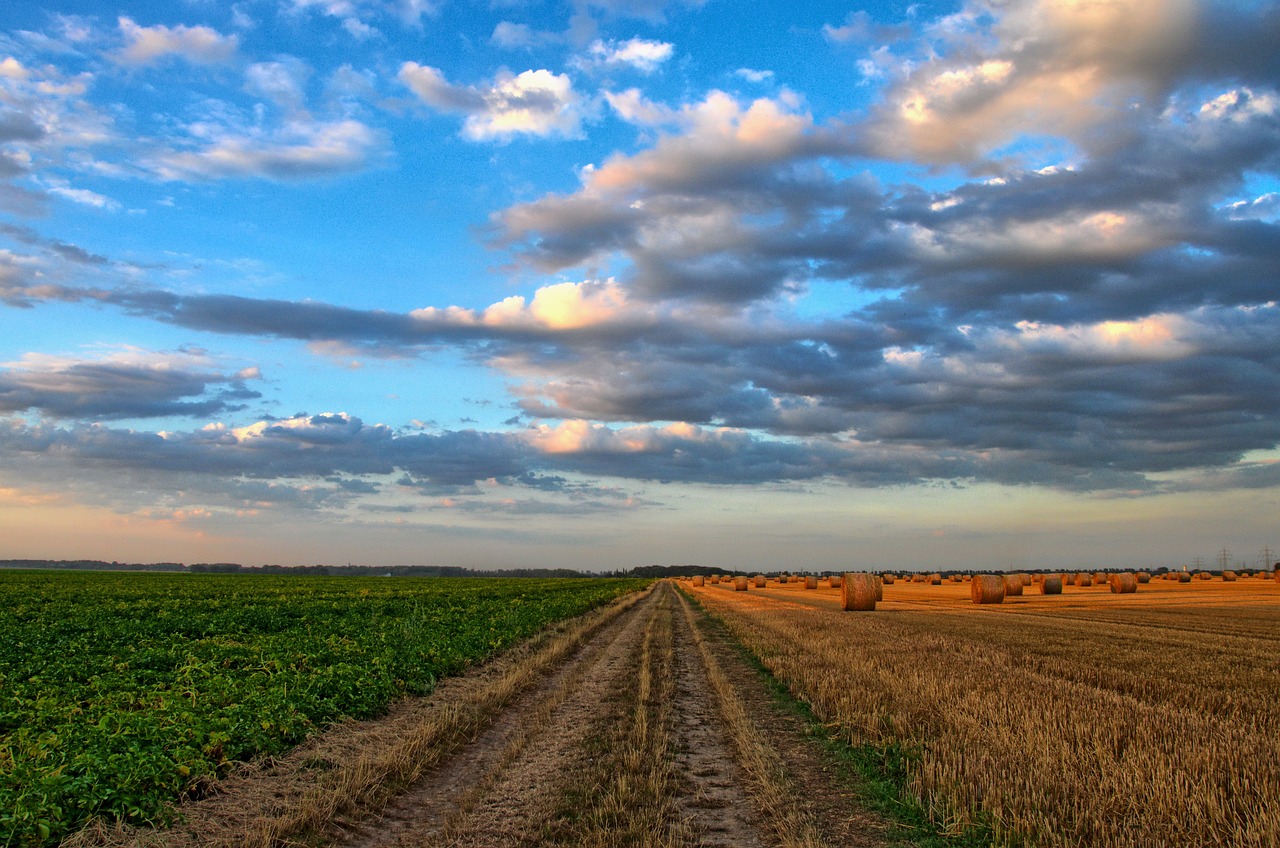
Download the PDF version
For the past two years, the concept of food sovereignty has been regularly discussed, debated, and often used as an argument to support the need for domestic production. Despite a positive trade balance, is the European Union of 27 countries capable of feeding itself? Is its internal production aimed at meeting the needs of its population or serving an agro-exporting agenda? The answer is not straightforward, and analyzing self-sufficiency ratios, export capacity, and import dependence across various sectors helps bring objective insights to the debate.
Food sovereignty for the majority of productions
An analysis of trade balances allows for studying the balance of exchanges across different sectors by considering the value of products, but it does not reflect the balance between production and consumption in terms of volume. It is possible to have a significant trade surplus or deficit for a high-value product, which may not accurately represent the volume in relation to consumption. Earlier this year, we analyzed a report from FranceAgriMer on French food sovereignty, which highlighted positive results for cereals and dairy products but also illustrated the decline in certain sectors, such as poultry or fruits and vegetables. We wanted to carry out a similar exercise at the scale of the European Union. The common market can indeed help balance the strengths and weaknesses of the various Member States.
We analyzed four categories of products: dairy products, meats, cereals, and oilseeds.
| Definition of the presented indicators (all figures presented and discussed refer to the EU 27): – Self-sufficiency rate (production/consumption): This reflects the apparent ability of a country to meet its needs through its own production. It considers the production achieved by EU countries in the current year (losses are deducted for cereals, and stocks are not taken into account). Apparent consumption includes stock variations and corresponds to: production + imports – exports. – Export capacity (exports/(production+imports)): This represents the share of production and imports that is exported, showing the export strength of the country as well as the dependence of this production on purchases from importing countries. – Import dependence (imports/apparent consumption): This is the share of imports in domestic consumption, which can be high despite a significant self-sufficiency rate. In this case, it reflects a mismatch between the finished product and consumer expectations, who may, for example, prefer to buy a cheaper imported product. |
European production manages to cover consumption in dairy products, cereals, and meat, with only the oilseeds and protein crops sector being in deficit. However, significant disparities can sometimes be observed within each of these sectors.
Table 1: food sovereignty indicators of the EU 27 (averages for 2019-2022, compared to the averages for 2009-2012 for a 10-year evolution), European Commission data, analysis Agriculture Stratégies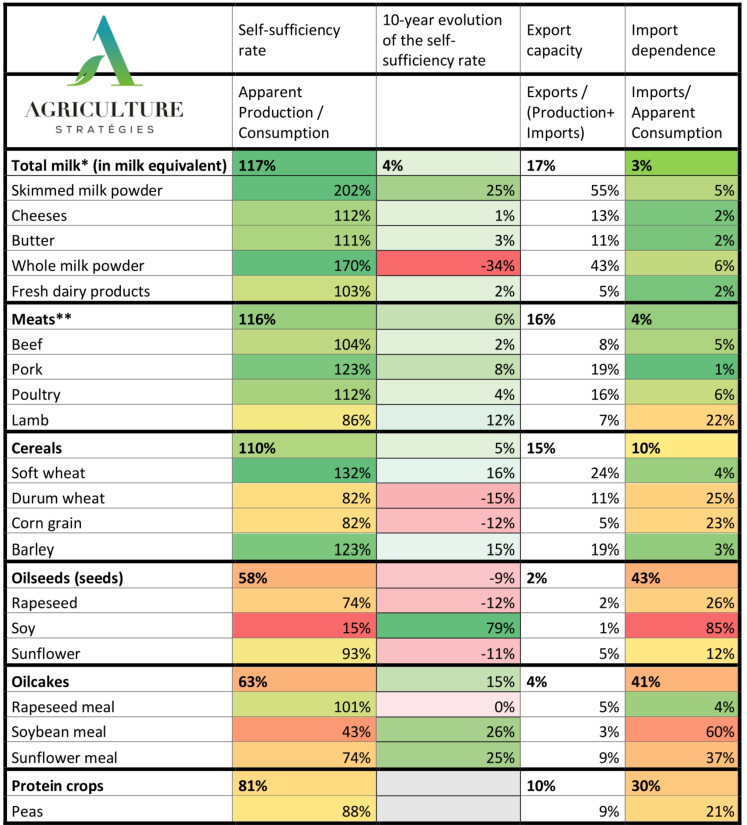
*Total milk: This refers to the milk collected divided by the apparent consumption of milk and dairy products (converted to milk equivalent). For this line, the presented three-year averages are calculated for 2019/21, with the evolution compared to the 2009/11 average. The import and export data converted to milk equivalent are based on the work of Vincent Chatellier (INRAE-SMART), using data from French Customs.
** The data on meats exclude the production and trade of live animals.
- Despite the reduction in livestock, good results for dairy products
The self-sufficiency rate in dairy products exceeds 100% for all product categories. No surprise here, as the EU is the world’s second-largest milk producer. Additionally, the decapitalization of the European dairy herd, whose numbers are steadily declining (the EU has 5 million fewer dairy cows than in 2000), is currently more than compensated by the increase in milk yields. Across all dairy products, production is sufficient to cover rising demand, and the EU’s milk self-sufficiency rate has been slightly increasing over the past 20 years, unlike France’s, which has been rapidly deteriorating in recent years, as production has not kept pace with consumption growth.
 Figure 1 : Apparent consumption and self-sufficiency rate in milk in the EU27 and France. Source: Agriculture Stratégies calculations based on European Commission and INRAE SMART data.
Figure 1 : Apparent consumption and self-sufficiency rate in milk in the EU27 and France. Source: Agriculture Stratégies calculations based on European Commission and INRAE SMART data.
This considers collected milk (based on European Commission data) divided by the apparent consumption of milk and dairy products. Apparent consumption corresponds to collection + imports – exports of milk and dairy products (converted into milk equivalent). Import and export data converted into milk equivalents are based on Vincent Chatellier’s (INRAE-SMART) work using French Customs data.
Different dairy products follow different trends. For cheese, butter, and fresh products, the EU remains self-sufficient without surplus. Notably, cheese consumption and exports are steadily increasing: while in 2010, a European consumed on average 17.8 kg of cheese per year, they were consuming 3 kg more in 2021. During the same period, exports increased by 30% (despite the loss of the Russian market, which accounted for nearly a third of cheese exports in 2013), but production growth has managed to maintain both export capacity and the consumption coverage rate.
Dependence on imports is low (less than 5%) for all dairy products, reflecting the good alignment between production and European demand. Skimmed and whole milk powders, which are more easily transported, and to a lesser extent butter and cheese, are more widely exported than fresh, perishable products, which are mostly traded within the EU. The top partner for powders and butter is by far China, a difficult trade partner to manage due to its unpredictable purchasing behavior, which involves large volumes and heavily influences the markets[1].
Skimmed milk powder production surged between 2014 and 2015 with the end of milk quotas (about +500,000 tons) and has remained stable since, contributing to an increase in export capacity and the self-sufficiency rate, which now hovers around 200%—in other words, the EU produces twice as much skimmed milk powder as it consumes. These significant surpluses specifically concern skimmed milk powder and, to a lesser extent, whole milk powder, whose production has already significantly decreased and returned to pre-quota levels.
- Production covers meat consumption, except for sheep meat
The situation also appears favorable for meats, where production covers consumption for beef, chicken, and pork. Meat consumption in the EU has remained very stable over the last ten years: Europeans consumed 67 kg per capita per year in 2010, and this figure remained the same in 2020. As in France, there is a slight decline in pork and beef consumption, offset by increasing demand for chicken.
 Figure 2: Evolution of meat consumption per capita per year in the EU27. Source: European Commission, processed by Agriculture Stratégies.
Figure 2: Evolution of meat consumption per capita per year in the EU27. Source: European Commission, processed by Agriculture Stratégies.
Beef production volumes fluctuated slightly over the decade and are now slightly below the levels observed 10 years ago (-3%). However, the slight decline in European beef consumption (10.4 kg consumed per capita on average between 2019 and 2022, compared to 11.0 kg for the period 2009-2012) helps maintain a sufficient self-sufficiency rate. Dependence on imports is much lower at the European level than in France, as imports account for only 5% of consumption, compared to 25.6% in France in 2022, even though France is the leading beef producer in the EU. The EU27 beef market is largely focused on internal trade: France exports live animals (mainly to Italy) and imports meat from the Netherlands, Ireland, Germany, Poland, and the UK, which has now become France’s main non-EU trading partner for beef. When live animal exchanges are included, France had a self-sufficiency rate of 111% for the period 2019-2022 (compared to 93% for meat alone), and the EU had a rate of 107% (compared to 104% for meat alone).
After a long period of stability, pork consumption has been declining since 2018, while pork production increased until 2021 to meet strong external demand, mainly driven by China. Since late 2021, Chinese imports have decreased in volume due to a resurgence of African swine fever (ASF), which has led to increased local slaughtering and a drop in prices[2]. ASF has also affected some European countries, causing difficulties for them to export and leading to an oversupply in the domestic market. Producers faced falling prices coupled with record-high production costs due to rising energy and feed expenses, putting the sector in what has been described as “the most severe crisis it has ever faced” [3]. In response to this crisis, only national measures were taken[4], while the European executive remained inactive. After two years of crisis, the situation in the sector is improving, largely because the European herd has been rapidly reduced (by 3% between 2020 and 2021, and by more than 5% between 2021 and 2022[5]) in a context that was endured rather than managed.
While France has not met its national demand for chicken meat since 2014 and its self-sufficiency rate decreases every year, the EU has a self-sufficiency rate of over 100%, and its dependence on imports is even slightly decreasing. This is partly due to the increase in production in Poland, which became the leading chicken producer in Europe in 2013 and whose production volumes continue to rise in order to meet growing domestic consumption as well as external markets. Domestic consumption increased by 20% between 2009-2012 and 2019-2022, and chicken meat exports jumped by 33%, driven by demand from the UK’s European customer.
The only meat for which production does not cover consumption is sheep meat, although the self-sufficiency rate has been increasing since 2008, but only due to a decline in community consumption, as production is decreasing. This situation will not improve with the implementation of new free trade agreements under negotiation with Oceania, which will open up new quotas for sheep meat.
- Heterogeneous trends in cereals
Cereals show mixed trends. While overall production covers the community’s needs in this sector, it is mainly due to barley and soft wheat, whose self-sufficiency rates exceed 120% and have been increasing over the past decade.
For soft wheat, the cultivated areas have remained stable, but average yields have improved despite significant annual variability. Domestic wheat consumption has slightly declined, so the production surplus is directed toward exports. The same applies to barley, where rising yields have more than compensated for the reduction in sown areas. Soft wheat exports have increased by 58% and barley exports by 67% over the decade. According to IGC data, the EU has supplied, on average, 16% of the global wheat and 24% of the global barley volumes traded over the past ten years.
In contrast to soft wheat and barley, maize production is no longer sufficient, and the self-sufficiency rate is deteriorating. The increase in the use of maize grain for animal feed and, to a much lesser extent, biofuels (in 2022, 76% of domestic maize grain consumption was for livestock and 8% for biofuels) has not been covered by stable production levels, leading to a surge in imports over the past decade. Dependency on maize grain imports rose from 10% on average between 2009-2012 to 23% between 2019-2022. The increased demand for maize is largely tied to the growth of monogastric livestock sectors. In France, it is estimated that maize grain use in animal feed is distributed as follows: 40% for poultry, 36% for pigs, 10% for dairy cattle, and 10% for beef cattle[6]. Contrary to some misconceptions, in the context of declining cattle herds, the rising demand for white meat drives the need for maize and also for soy (remember that 44% of imported soymeal in France is used for poultry).
Maize imports mainly come from Ukraine and Brazil (57% and 23% of EU maize imports, respectively, on average between 2019 and 2022), and maize is currently excluded from the list of products subject to the regulation on imported deforestation. Maize imports are also motivated by the ability to import more competitive GMO maize: there are now more than 200 GM maize varieties authorized for import, with several dozen varieties[7] for each modified gene or gene combination allowed into the European market. Therefore, hundreds of different GM maize varieties can be used for human and/or animal consumption, even though cultivation is not authorized in the EU, and new authorizations are granted each year[8].
The self-sufficiency rate for durum wheat[9] is also declining, but for different reasons: while consumption remains stable, durum wheat production and exports are decreasing. The production drop can be explained by a reduction in sown areas (especially in Spain and France[10]), driven by the crop’s lower profitability compared to soft wheat, along with significant yield variability, which can discourage farmers.
Weaknesses, particularly in oilseeds
- The EU depends on imports for its oilseed and protein needs
In the case of oilseeds, European production covers only 58% of consumption. This low ratio is primarily due to the well-known shortage of soybean production: the EU’s self-sufficiency rate for soybeans is only 15% (2.5 million tons produced versus 16.2 million tons consumed in 2022). Although unsatisfactory, the situation is improving: production has nearly tripled in the past 10 years, thanks to a sharp increase in planted areas since 2015 (due to the implementation of coupled aid for soy), while consumption has stabilized. Demand has remained stable over the past decade, and soybean meal imports are decreasing due to increased production and, more importantly, internal processing.
To assess the level of dependence or self-sufficiency in oilseeds, it’s important to consider both seed production and trade, as well as meal and oil exchanges. A country with sufficient processing capacity may achieve good autonomy in soybean meal, but that autonomy might depend on importing seeds to supply the factories. Conversely, a country with few crushing plants may rely on its own production to supply those plants, achieving a good self-sufficiency rate for seeds but being heavily dependent on meal imports, as it cannot produce enough to meet domestic demand.
European and French performances are thus opposite: in soybeans, France has a better self-sufficiency rate in seeds (48%), but this is due to low domestic demand because France lacks crushing plants; it produces only 13% of the soybean meal it consumes[11]. The EU, on the other hand, has a self-sufficiency rate of 43% for soybean meal, but this heavily relies on seed imports.
When considering all meals for the EU, the self-sufficiency rate rises to 63% (it is 41% for France), and this rate is improving, but at the cost of increasing oilseed imports. For sunflower and rapeseed production, the ratios remain satisfactory (with self-sufficiency rates of 93% and 74%, respectively). However, the trend is concerning: the increase in cultivated areas and production is not keeping pace with consumption growth, as rapeseed and sunflower oils and meals can substitute for soybeans. Rapeseed demand has more than doubled since the early 2000s, and sunflower demand is also steadily increasing. As a result, the self-sufficiency rate for these two crops has dropped by 10 points over the past decade, and dependence on imports has significantly increased. For rapeseed, crushing capacity has adapted to meet the rising demand (also linked to the development of biodiesel, as rapeseed oil is used in its production), and the meal consumed is produced in Europe. However, for sunflower, despite increased domestic production, a significant portion of the meal consumed (37%) is still imported.
The EU’s production of protein crops also fails to meet internal demand, with stable areas around 2.1 million hectares. The European Commission aims to reach 2.8 million hectares by 2032, which, combined with a projected 14% yield increase, should, according to them, meet the growing demand for animal feed[12]. However, these forecasts seem overly optimistic, given that yields have stagnated.
Conclusions
As France’s food sovereignty declines, the improvement of the EU’s is made possible by the growing agricultural power of countries like Poland and Spain, sometimes at the cost of intensifying farming practices that harm the environment. It is therefore even more important to ensure that all Member States move in a common direction on agroecological transition, a delicate task due to the lack of harmonization in national laws and the differences within the NSPs, particularly regarding the application methods of eco-schemes.
Upcoming European regulations (particularly regarding pesticides, animal welfare, and nature restoration) could provide an opportunity to reduce, at least partially, internal competition distortions. However, achieving the goals set out through the Green Deal and the Farm to Fork strategy may impact the current production levels in the EU, leading some observers and professionals to question its effects on the EU’s food sovereignty, its ability to feed itself, and its capacity to supply external markets, whose volatility will be amplified by a reduction in European supply.
The production of studies on the cumulative impacts of these various strategies on production and prices is essential. The Commission’s latest response, given on last July 5th[13], raises concerns about the differentiated implementation of the Sustainable Use of Pesticides Regulation across Member States. If each Member State independently prioritizes pesticide reductions based on sectors, crops, and regions of its choosing, the necessary standardization of practices across the European space cannot be achieved. Furthermore, these policies must not reinforce dependence on deficient production sectors in favor of those that remain more profitable.
Current trends must not be overlooked: for instance, while European dairy production currently seems more than sufficient to meet demand, the continuation or potential acceleration of the downsizing of the dairy herd could eventually halt these dynamics. Reducing the dairy herd may seem desirable to some, given the significant surpluses in skimmed milk powder, but it’s also important to note that reducing skimmed milk powder production would lead to a decrease in fat availability, which is currently close to being in balance with consumption.
Thus, pursuing the goal of reducing greenhouse gas emissions must consider consumption trends, especially in meat. Any reduction in European production, accompanied by rising production costs, must be supported and protected to prevent it from being offset by an increase in more competitive imports, which could have a worse carbon and environmental footprint.
Alessandra Kirsch, Director of studies at Agriculture Stratégies
Lore-Elène Jan, Consultant at Agriculture Stratégies
Translation by Marlène Stickel, AgroParisTech Alumni President
September 29, 2023
[1] https://www.tendances-lait-viande.fr/category/lait-de-vache/?numero=349
[2] https://www.franceagrimer.fr/fam/content/download/68258/document/NCO-DIAL-VBL-Conjoncture%202022-02-02.pdf?version=1
[3] https://www.euractiv.fr/section/energie-climat/news/commission-still-hesitant-to-step-in-and-relieve-distressed-pig-farmers/
[4] https://agriculture.gouv.fr/le-ministre-en-charge-de-lagriculture-annonce-un-plan-de-sauvegarde-de-la-filiere-porcine-face-une
[5] https://agreste.agriculture.gouv.fr/agreste-web/download/publication/publie/SynAbo23406/consyn406202305-Porcins.pdf
[6] According to https://www.gis-avenir-elevages.org/content/download/3690/36029/version/1/file/synthese_Avenir_Elevages_2020.pdf
[7] https://twitter.com/DurocYann/status/1616485648893870088
[8] List of authorized GMOs: https://webgate.ec.europa.eu/dyna2/gm-register/
[9] It should be noted that, unlike the figures presented for France by FranceAgriMer, these reports do not include semolina and pasta.
[10]https://www.franceagrimer.fr/fam/content/download/63307/document/Bilan%20Bl%C3%A9%20dur%202019-2020.pdf?version=1
[11] According to the annual agri-food supply reports from Agreste.
[12] https://agriculture.ec.europa.eu/system/files/2023-04/agricultural-outlook-2022-report_en_0.pdf
[13] https://food.ec.europa.eu/system/files/2023-07/pesticides_sup_commission-response_art-241.pdf


